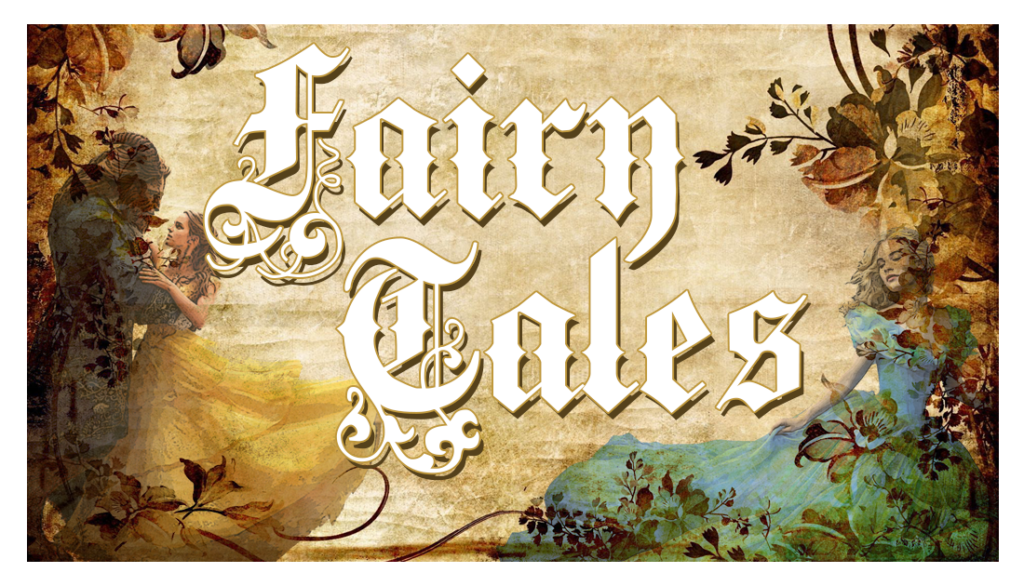Table of Contents
RIDING HOODS
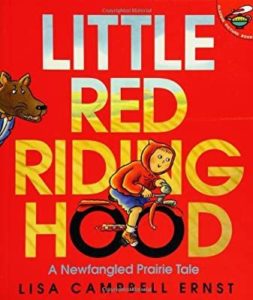
|
In Lisa Campbell Ernst’s Little Red Riding Hood: A Newfangled Prairie Tale (Simon & Schuster, 1998), Little Red wears a hoodie and rides a bicycle, and Grandma is a feisty feminist type who drives a tractor and bakes great muffins. Little Red learns not to talk to strangers, and the Wolf – after a sharp talking-to – ends up as Grandma’s assistant muffin cook. A muffin recipe is included. For ages 4-8. |
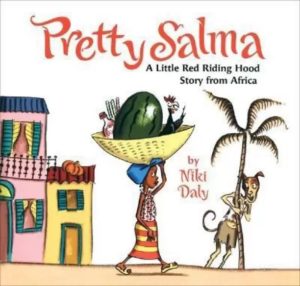
|
Niki Daly’s Pretty Salma (Clarion, 2007) is a Little Red Riding Hood story set in Ghana. Pretty Salma dresses up in her blue scarf, yellow sandals, and striped ntama – a sort of sarong – and heads off to the market, with a strict warning from her Grandma about talking to strangers. There she buys an enormous watermelon, a speckled rooster, and a pink drink, and starts back home – only to be thoroughly waylaid and tricked by the devious Mr. Dog. Mr. Dog, now dressed in Salma’s clothes, prepares to trick Grandma, but Salma – with some help from Grandpa and a scary bogeyman mask – arrives in time to save the day. For ages 4-8. |
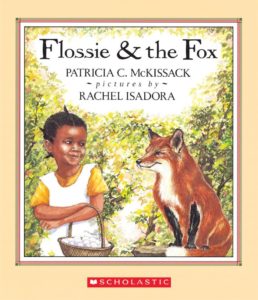
|
In Patricia McKissack’s picture book Flossie and the Fox (Dial, 1986), an African-American take on Red Riding Hood, Flossie’s mama sends her through the woods to bring a basket of eggs to Miz Viola – but warns her to look out for the lurking fox. Flossie doesn’t know what a fox looks like, so when one shows up, she steadfastedly refuses to believe that he’s the scary character he insists he is. For ages 4-8. |
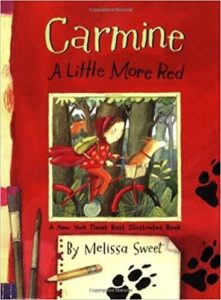
|
In Melissa Sweet’s Carmine: A Little More Red (Sandpiper, 2008), Carmine has been taught to read by her Granny, using the letters in bowls of alphabet soup. The story is told in part in alphabetical order, using words spelled out in alphabet-soup letters (CLUTTER, DILLY-DALLY, EXQUISITE, MIMIC, NINCOMPOOP). Carmine and dog Rufus set off to visit Granny and share a bowl of alphabet soup, but pause along the way to paint a picture – and are spotted by the wolf. Off he heads for Granny’s house, but ends up making off with nothing but soup bones. (Included is a recipe for Granny’s alphabet soup.) Wonderful witty paint-and-collage illustrations feature every possible shade of red. For ages 4 and up. |
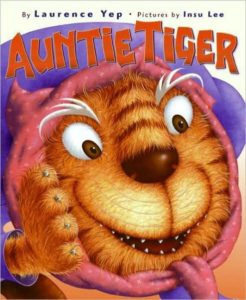
|
Lawrence Yep’s Auntie Tiger (HarperCollins, 2008) is a Chinese Red Riding Hood tale in which Big Sister and Little Sister – who quarrel all the time – are left alone at home with an admonition from their mother not to open the door while she’s gone. When a hungry tiger shows up pretending to be the girls’ Auntie, Little Sister foolishly lets him in – and is promptly gobbled up whole. Big Sister, however, manages to defeat the tiger and save her sister, and the chastened girls vow to get along better in the future. For ages 5-8. |
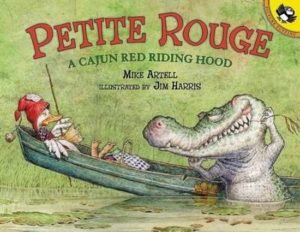
|
In Mike Artell’s Petite Rouge (Puffin, 2003), set in the Louisiana bayou, Little Red Riding Hood (Petite Rouge) is a duck, sent to bring her sick Grandma a basket of gumbo and boudin (sausage), but warned to steer clear of the nasty gator, Claude. She doesn’t, and the wicked Claude ends up in Grandma’s bed, wearing frilly pajamas, flippers, and a rubber beak. Petite Rouge deals with him by tossing a hot-sauce-drenched sausage into his mouth. The story is told in rhyme in Cajun dialect (“Take her dis gumbo/an’ t’ree or two sweater/An’ some uh dis boudin/gone make her feel better”), which I found grating, but the illustrations are witty and hilarious. For ages 5-8. |
| Also by Mike Artell, see The Three Little Cajun Pigs (Dial, 2006), in which Trosclair, Thiboudeaux, and Ulysse build houses of straw, sticks, and bricks, the first two of which Claude the hungry gator does in which a swipe of his tail; and Jacques and de Beanstalk (Dial, 2010), in which the beanstalk sprouts in a mangrove swamp. | |
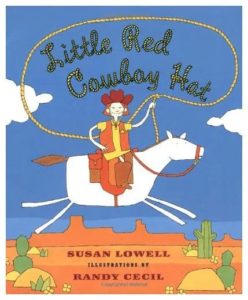
|
In Susan Lowell’s Little Red Cowboy Hat (Square Fish, 2004), Little Red is a feisty frontier girl with hair the color of firecrackers, who wears cowboy gear and shoots rattlesnakes with her slingshot. Off she goes on horseback to bring her Grandma a jar of cactus jelly, and soon encounters a black-hatted wolf, lurking behind a saguaro cactus. Red and Grandma, no pushovers, dispatch the wolf, and the lesson learned is “A girl’s gotta stick up for herself.” For ages 5-8. |
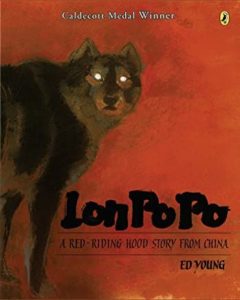
|
In Ed Young’s Lon Po Po (Puffin, 1996), a Red Riding Hood tale from China, three little girls deal with a truly menacing wolf who shows up at the door pretending to be their grandmother. For ages 5-8. |
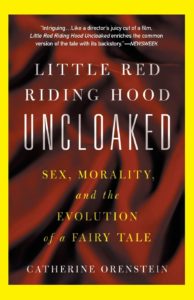 |
Catherine Orenstein’s Little Red Riding Hood Uncloaked: Sex, Morality, and the Evolution of a Fairy Tale (Basic Books, 2003) traces the complex history and many permutations of the Little Red Riding Hood story. Charles Perrault’s early tale, Orenstein explains, served as a lesson to innocent young girls entering the sinful and politically tricky court of Louis XIV. For older teenagers and adults. |
| From the University of Southern Mississippi, The Little Red Riding Hood Project has texts and images from historical versions of Little Red Riding Hood. | |
| From the San Francisco Exploratorium, Ladle Rat Rotten Hut is a Red Riding Hood version written in 1940 by a professor who wanted to show his students that intonation in language is integral to meaning. Try it! You’ll be surprised… | |
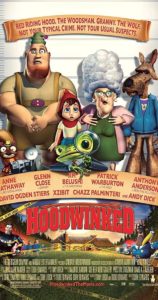
|
The CGI film Hoodwinked (The Weinstein Company, 2005) purports to be the true story of Little Red Riding Hood. It’s a detective story, in which Red, the Wolf, the Woodsman, and Granny all have very different takes on the real story. (The Wolf, in fact, turns out to be an investigative reporter, with a squirrel sidekick/cameraperson named – appropriately – Twitchy.) Rated PG. |
